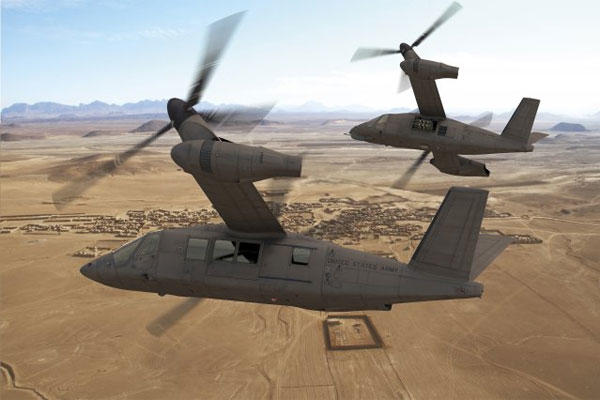A top official from Bell Helicopter said the company's design for the U.S. Army's future tiltrotor fleet will be far different than the 30-year-old design of the V-22 Osprey.
The chopper, known as the V-280 Valor, is part of the Army's Joint Multi-Role Demonstrator program to develop the technology for the Pentagon's Future Vertical Lift program.
The concept aircraft advances the design of the V-22, the first tiltrotor aircraft flown by Marine Corps and Air Force, according to Vince Tobin, vice president of Advanced Tiltrotor Systems for Bell Helicopter.
"The V-22 has instructed on what tiltrotors can do, and that is great, but the V-280 is not a V-22," Tobin told an audience Thursday at an Army aviation symposium put on by the Association of the United States Army.
"We are going to do it better than we did on the V-22. The V-22 was designed in the 1980s ... and we have taken it under our imperatives to fix what wasn't perfect on the V-22 and get as close to perfect as we can on the V-280."
Bell, which is owned by Textron Inc., partnered with Lockheed to develop the V-280, which is scheduled to make its first demonstration flight next year.
The Army's development effort could lead to a potentially $100 billion Future Vertical Lift program to replace the service's fleets of UH-60 Black Hawk utility helicopters made by Sikorsky and AH-64 Apache attack helicopters made by Boeing, though any aircraft probably wouldn't enter service until the 2030s.
"Back in 2011, one of the first things we wrestled with is do we want a ramp or do we want a ramp or do we want doors," Tobin said. "We ended up making the decision that the Army comes out of medium aircraft out of side doors. It was a bigger deal than you might think because if you know about a V-22, the entire cell rotates engine and all ... and everything that has to go between that has to go through that rotation point.
"We had fellow engineers that were pretty convinced that there was no way that you could not rotate the engines. It took us having to show a picture of the XV2 -- the very first tiltrotor ... that picture gave the engineers a little bit of a challenge that said the fellow engineers of the 1950s figured it out so we need to figure it out."
The resulting fixed-engine design opened the door for other improvements, Tobin said. In addition to allowing for side doors, the new design resulted in an improved wing design, he said.
Engineers originally thought that the wings on the V-22 had to be swept forward, Tobin said.
"The reason why V-22 wings are swept forward is because the engineers at the time didn't know how far the blades would flap in forward flight," Tobin said. "If you don't know how far the blades are going to flap, you better sweep the wings forward so the blades and the wings don't come in contact with each other.
"What we learned from over 300,000 hours now of V-22 flying is those blades don't flap in forward flight."
Selecting a straight wing design meant that that the mid-wing gear box was unneeded, Tobin said.
"Now we don't have to have a drive system coming into change the direction over top of the fuselage like on the V-22s ... that was a big deal -- no mid-wing gear box. We are down from five gear boxes on a V-22 to four."
The new wing design is now ready for the upcoming demonstration, Tobin said.
"We actually have a wing put together for the demonstrator -- the upper and lower surfaces are on the wing, all the hydraulics lines, all the electrical and all the test equipment is inside," Tobin said. "We are putting this airplane together, and we expect to fly it in the fall of 2017."
-- Matthew Cox can be reached at matthew.cox@military.com.
Related video:



























